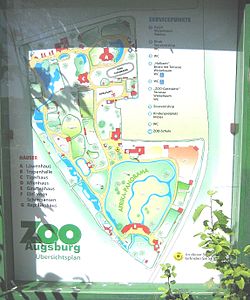| Zoo Augsburg | |
|---|---|
 | |
 | |
 | |
| 48°20′52″N10°54′52″E / 48.34778°N 10.91444°E | |
| Date opened | 12 May 1937 |
| Location | Brehmplatz 1, 86161 Augsburg, Germany |
| Land area | 22 ha (0.22 km2) |
| No. of animals | 1245 [1] (2013) |
| No. of species | 236 [1] (2013) |
| Annual visitors | 600 000 |
| Memberships | WAZA, EAZA, VDZ |
| Owner | Zoologischer Garten Augsburg GmbH |
| Director | Barbara Jantschke |
| Website | www |

Augsburg Zoo is a zoo located in the city of Augsburg in Bavaria, Germany, and with over 600,000 visitors annually, the zoo belongs to the 20 largest Zoos in Germany.
Contents
Augsburg Zoo holds 1,600 animals belonging to 300 different species. Of those animals, the zoo keeps 100 reptiles and amphibians from 25 species. The zoo is involved in the 18 European Endangered Species Programmes.





